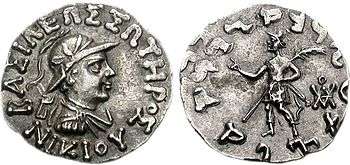Nicias (Indo-Greek king)
| Nicias | |
|---|---|
| Indo-Greek king | |
|
Coin of king Nicias (c. 90–85 BCE) Obv: Bust of Nicias with Greek legend BASILEOS SOTEROS NIKIOU "Of Saviour King Nicias". Rev: King in armour, holding a palm of victory in his left hand, and making a gesture of benediction with his right hand, similar to the Buddhist vitarka mudra. Kharoshti legend MAHARAJA TRATARASA NIKIASA "Saviour King Nicias". | |
| Reign | 90–85 BCE |
Nicias (Greek: Νικίας) was an Indo-Greek king who ruled in the Paropamisade. Most of his relatively few coins have been found in northern Pakistan, indicating that he ruled a smaller principate around the lower Kabul valley. He was possibly a relative of Menander I.
Time of reign
Bopearachchi suggests that Nikias ruled ca. 90–85 BCE. This late date is supported by the absence of Attic coins (see below).
R. C. Senior on the other hand places him as a successor of Menander, ca. 135–125 BCE, according to his interpretation of hoard findings.
Regardless of which period is correct, the fact that Nicias ages visibly on his coins seems to indicate some longevity to his rule.
The coinage of Nicias

Nicias struck Indian silver drachms of diademed or helmeted king with three reverses:
- A walking king, as seen above right, found on several drachms.
- An en face version of Menander's Athena with thunderbolt is found on a unique tetradrachm.
- The third reverse is the type king on a prancing horse, as used by Antimachus II found on a single drachm.
His bronzes feature Zeus/dolphin or portrait / king on prancing horse. Some varieties are crude with lunate sigmas and square omicrons. Even though Nikias ruled in the western parts of the Indo-Greek realm, no Attic coins have been found.
His monograms generally match those of the kings Theophilus and Philoxenus, though one is shared with Thrason, the short-lived son of Menander I.
See also
- Greco-Bactrian Kingdom
- Seleucid Empire
- Greco-Buddhism
- Indo-Scythians
- Indo-Parthian Kingdom
- Kushan Empire
References
- The Shape of Ancient Thought. Comparative studies in Greek and Indian Philosophies by Thomas McEvilley (Allworth Press and the School of Visual Arts, 2002) ISBN 1-58115-203-5
- The Greeks in Bactria and India, W.W. Tarn, Cambridge University Press.
External links
| Preceded by Theophilos |
Indo-Greek ruler in Paropamisadae 90–85 BCE |
Succeeded by Hermaeus |
- ↑ O. Bopearachchi, "Monnaies gréco-bactriennes et indo-grecques, Catalogue raisonné", Bibliothèque Nationale, Paris, 1991, p.453
- ↑ History of Early Stone Sculpture at Mathura: Ca. 150 BCE - 100 CE, Sonya Rhie Quintanilla, BRILL, 2007, p.9
